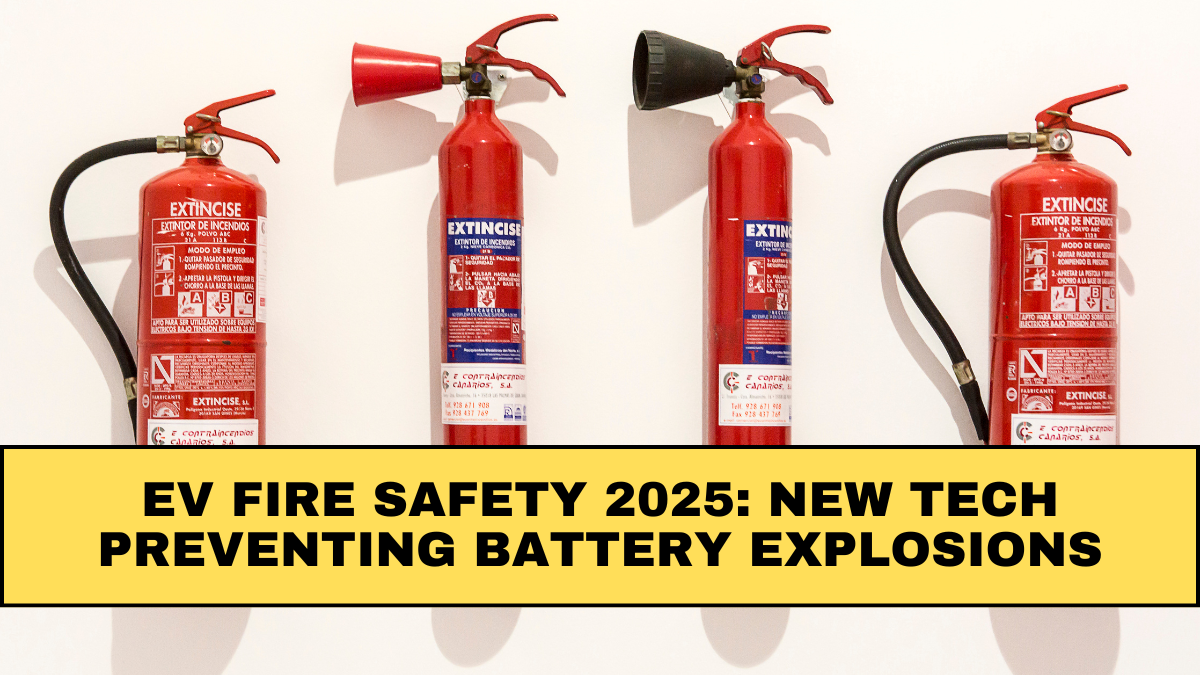Electric vehicles continue to grow across India and global markets, and with them comes a rising focus on EV fire safety. While EV fires are statistically rare, the risks from lithium-ion batteries make safety innovation essential. In 2025, automakers and battery companies are rolling out smarter technologies to reduce overheating, detect faults early, and prevent thermal runaway. These improvements are helping drivers feel more confident than ever about choosing an electric vehicle.
Governments and safety agencies are also tightening standards, pushing manufacturers to adopt real-time monitoring and safer battery chemistries. From AI-driven alerts to fire-resistant materials, EVs today are becoming safer by design rather than relying solely on external regulation. The new technology wave isn’t just reactive—it aims to stop battery failures before they happen.

Smarter Battery Sensors & AI Alerts
One of the biggest advancements in EV fire safety 2025 is the use of high-precision sensors placed inside battery packs. These sensors track temperature spikes, voltage imbalance, and unusual chemical reactions. If anything appears abnormal, the BMS (Battery Management System) triggers instant alerts and may even isolate the faulty cell.
AI models have entered the picture as well. They can study battery behavior in real time and predict risky patterns hours before failure. This early warning capability means technicians or drivers can take action long before a fire ever has a chance to start. Many new EVs now provide warnings on dashboards and mobile apps, ensuring complete visibility over battery health.
Safer Battery Chemistry & Cooling Systems
Another major progress area is the shift toward LFP (Lithium Iron Phosphate) batteries, which are naturally more resistant to overheating. These batteries reduce the risk of thermal runaway, one of the leading causes of EV fires. Automakers in 2025 are combining LFP chemistry with stronger battery enclosures that prevent fire spread even in case of collisions.
Improved cooling systems also play a vital role. Liquid-cooling setups have become more common, distributing heat more evenly and lowering stress on cells. Some premium EVs now feature dual-cooling circuits that activate during heavy acceleration or fast charging. Together, these upgrades keep the battery pack stable even in extreme heat conditions.
Fire-Resistant Materials & Auto-Disconnect Technology
EV manufacturers are investing in fire-retardant materials, especially around wiring and battery housing. These materials slow fire progression and protect the cabin long enough for occupants to exit safely. In 2025, many models include heat-shield coatings designed to stop flames from reaching sensitive electronics.
Auto-disconnect systems are another breakthrough. In case of a crash or short circuit, the vehicle instantly cuts off the power supply from the battery to the rest of the car. This prevents sparks, reduces the chances of ignition, and protects rescue teams working on accident scenes. These systems add a new layer of safety during emergencies.
Charging Safety Improvements
Public charging stations and home chargers now come with stricter safety protocols. Smart chargers monitor the battery’s condition and adjust power levels automatically. If they sense overheating, charging slows down or stops altogether. Fast-charging hubs in 2025 also include cooling pads and thermal safeguards that keep temperatures under control during high-power charging sessions.
As EV adoption spreads, educating users is equally important. Automakers are now providing clearer guidelines for charging habits, cable care, and parking safety. These simple best practices significantly reduce misuse, which is often behind overheating incidents.
Conclusion
The advancements in EV fire safety 2025 show how quickly the industry is evolving to protect drivers and passengers. With predictive AI, stronger battery materials, smarter sensors, and safer charging systems, EVs today are built with multiple layers of protection. While no technology is completely risk-free, the innovations rolling out this year make electric vehicles far safer than ever before. For new buyers, these improvements offer peace of mind and strengthen the shift toward clean mobility.
FAQs
How common are EV fires?
EV fires are rare compared to petrol or diesel cars, but safety technology continues to improve to reduce risks even further.
What causes EV battery fires?
Thermal runaway, overheating, manufacturing defects, or physical damage are the main triggers, though newer systems detect these early.
Are LFP batteries safer?
Yes, LFP batteries are more stable and less prone to overheating, making them a preferred choice in 2025 models.
Do fast chargers increase fire risk?
Not with modern safeguards. Smart chargers adjust power and stop charging if temperatures rise.
How can EV owners improve safety?
Avoid overcharging, use certified chargers, update vehicle software, and keep the battery within recommended temperature ranges.
